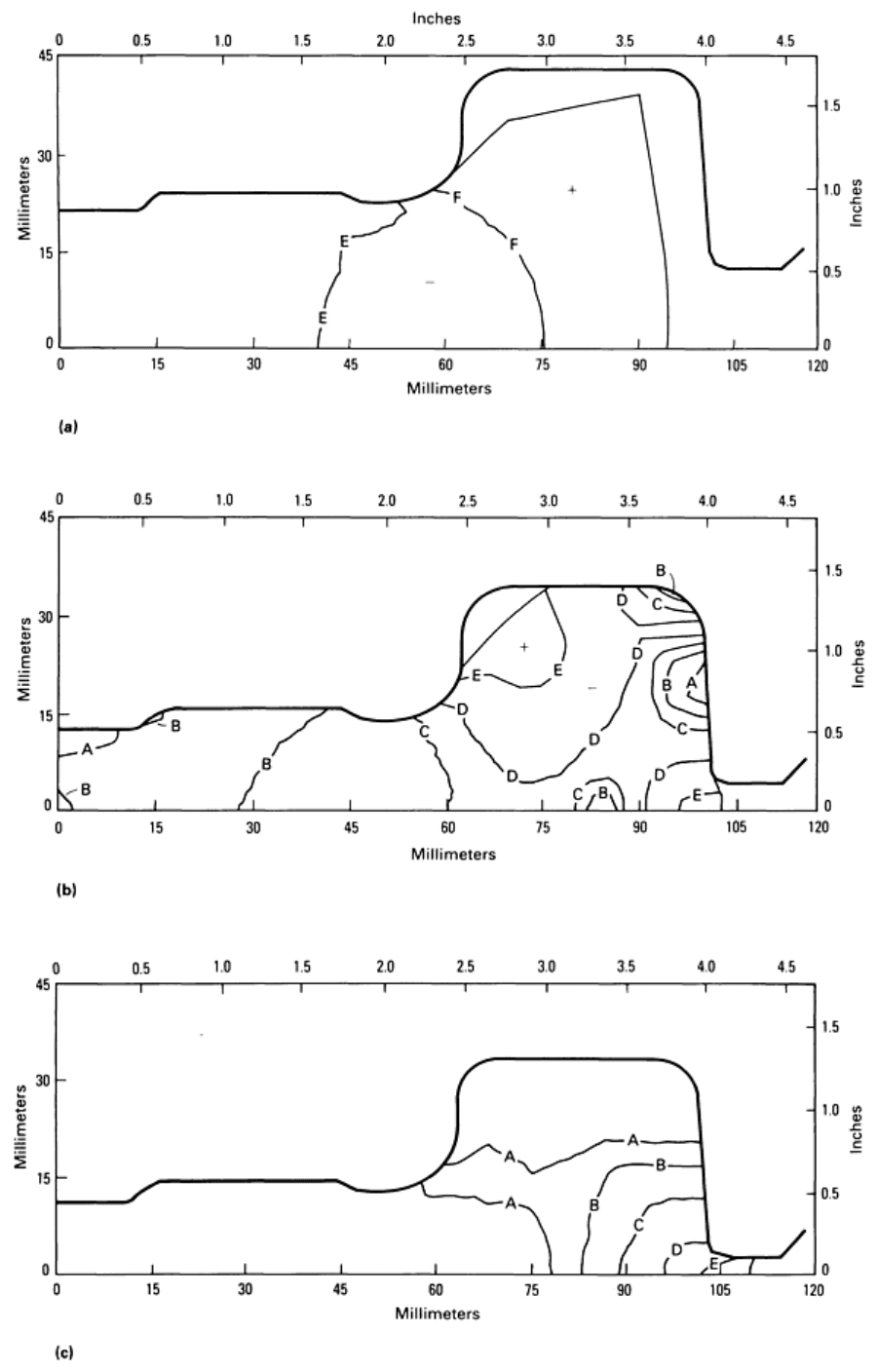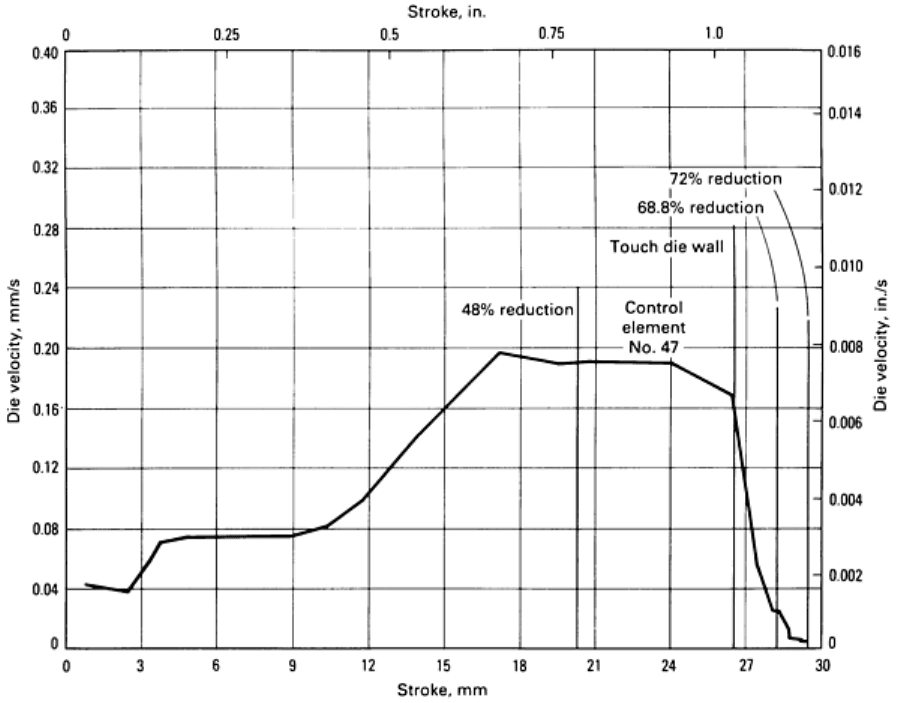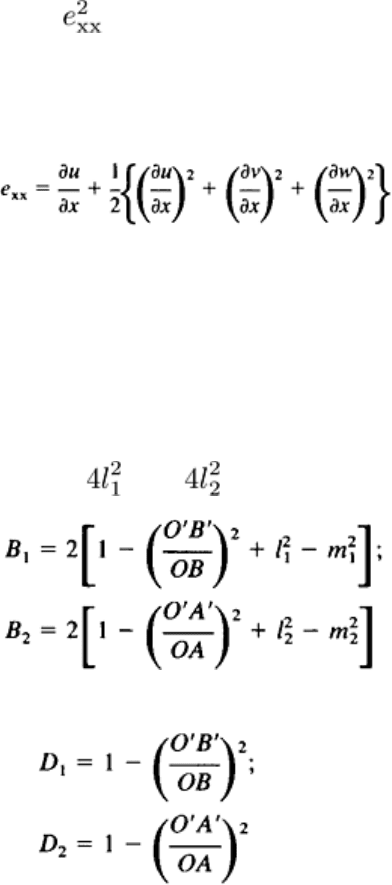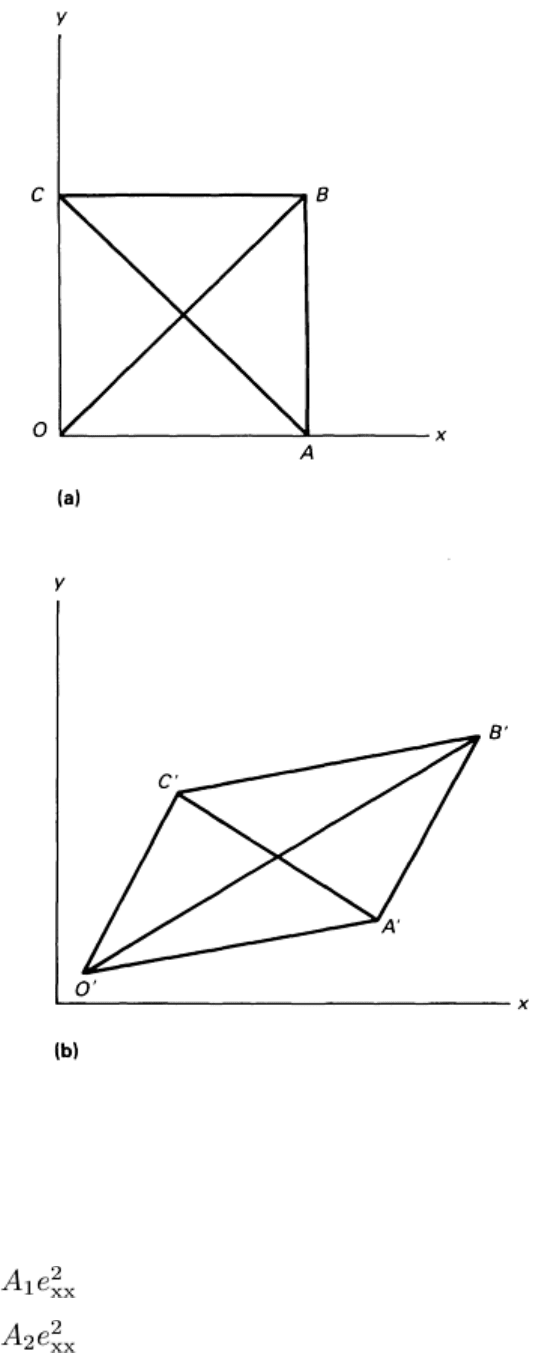ASM Metals HandBook Vol. 14 - Forming and Forging
Подождите немного. Документ загружается.


and 72.1 % (c) reductions in height. See also Fig. 20, 21, and 22.
In the current study, the process design goal was to fill the die cavity completely and to avoid the possibility of creating
defects that are governed by the state of stress in the forging process. The state of stress is described here as the stress rate
path, which is defined as the ratio of the mean hydrostatic stress to the effective stress . This is a fundamental quantity
in plasticity theory because a material changes shape according to the applied effective stress rate path. When this ratio is
positive, a tensile state of stress exists; when it is negative, a compressive state of stress exists. The magnitude of the ratio
describes the approximate state of stress. For example, when
m
/ = + , the stress state is uniaxial tension; when
m
/
= - , the deformation state of ideal axisymmetric extrusion exists.
The distributions of the stress rate path ratio for the disk simulation at 48, 68, and 72.1% reductions in height are shown in
Fig. 20. At 48% reduction (Fig. 20a), the bore region of the disk has an approximate value of -1.0, and the rim region has
positive values that reach a maximum of +0.37.

Fig. 20 Effective strain rate-path ratio contour plots of disk-for
ging simulation at 48% (a), 68.8% (b), and
72.1% (c) reductions in height. See also Fig. 19, 21, and 22.
The transition from compression to tension (neutral surface) is controlled by the die radii. As the workpiece touches the
outside die wall and continues to fill the die cavity, the tensile state of stress reduces to a small region that is filling the
inside die corner. This situation presents a potential problem, namely, that of producing defects such as cavities or cracks
in the finished forging. Therefore, enhanced metal flow and good intrinsic workability of the workpiece are needed in this
location at the final stages of die filling in order to relax the stresses and thus avoid the possibility of defect formation.
Based on the stability map for Ti-6Al-2Sn-4Zr-2Mo with an initial β (Widmanstätten) microstructure, a strain rate of 3 ×
10
-3
s
-1
and a temperature of 926 °C (1700 °F) were determined as the optimum conditions for this material and
application. In optimizing the ALPID simulation of the isothermal disk-forging process, the die velocity was changed to
maintain an effective strain rate of 3 × 10
-3
s
-1
with a 0.1% tolerance limit in Element No. 47, which is positioned near the
inside die corner (Fig. 21) where final die filling is critical.


Fig. 21 Grid distortion plots of disk-
forging simulation with constant die velocity at 48% (a), 68% (b), and
72.1% (c) reductions in height. The black grid is Element No. 47; see text for explanation. See also Fig. 19, 20
,
and 22.
The optimal die velocity as a function of stroke is shown in Fig. 22, and a total deformation time of 413.4 s was required
for this type of process control. The die velocity gradually increases from 0.04 mm/s to a speed of 0.20 mm/s at a stroke
of 17 mm; the die velocity remains constant at about 0.20 mm/s until the workpiece touches the die wall at a stroke of
26.5 mm. At this point, the die velocity decreases drastically to a speed of 0.01 mm/s at the final stroke. The time-varying
die velocity results of this simulation would provide the enhanced workability and metal flow required for the workpiece
to flow around the die corner radii, to fill the inside die corner, and to fill the die cavity completely. Similarly, for
complicated die geometries, it is possible to vary die velocity as a function of time and to optimize the material flow to
achieve a given range of strain rate.
Fig. 22 Die velocity versus stroke curve for disk-forging simulation. See also Fig. 19, 20, and 21.
It is currently feasible to preprogram large hydraulic forging presses for constant or variable die velocity over a given load
range (Ref 64, 65). Feedback control systems can also be installed for regulating the ram speed with respect to forging
pressure or product temperature. Continuous control of the ram speed requires a combination of direct pumping and
accumulator drive systems in order to maintain the time-dependent power requirements of the forging process. The
accumulator drive system provides a higher penetration speed, but toward the end of the stroke, as the force required for
forging increases, the ram speed and load available at the ram decrease. The direct-drive system delivers the maximum
available load during the entire ram stroke and thus provides the very high pressures required for final die filling.
Therefore, the two drive systems are complementary, with the result being higher deformation rates and pressures. More
information on drive systems for both hydraulic and mechanical forging presses is available in the article "Hammers and
Presses for Forging" in this Volume.

References cited in this section
58.
J.C. Malas, "A Thermodynamic and Continuum Approach to the Design and Control of Precision Forging
Processes," Wright State University, 1985
60.
J.C. Malas, J.T. Morgan, H.L. Gegel, J.S. Gunasekera, S.M. Doraivelu, and S.I.
Oh, An Investigation on the
Mathematical-Modeling Technique Used for Analyzing Industrial Metalworking Processes, in
Proceedings
of the Eleventh NAMRC Conference (Madison, WI), May 1983
61.
S.I. Oh, S.L. Semiatin, S.M. Hwang, J.J. Park, W.T. Wu, and T. Al
tan, "Processing Science Research to
Develop Scientific Methods for Controlling Metal Flow, Microstructures, and Properties in 3-
D Metal
Forming Processes," Final Report AFWAL-TR87-4077, Wright-Patterson Air Force Base, Sept 1987
62.
H. Gegel, Future Directions of CAD/CAM/CAE in Manufacturing Overview, in
Proceedings of the
AUTOFACT '87 Conference (Detroit, MI), 1987
63.
J.A. Ficke, S.I. Oh, and J.C. Malas, FEM Simulation of Closed Die Forging of Isothermal Titanium Disk
Forging Using ALPID, in Proceedings of the 1984 Manufacturing Engineering Transactions, NAMRC XIII,
Society of Manufacturing Engineers, May 1986
64.
D.F. Wilhelm, Understanding Presses and Press Operations, Society of Manufacturing Engineers, 1981
65.
T. Altan, F.W. Boulger, J.R. Herman,
and H.J. Henning, Forging Equipment, Materials, and Processes, in
Metals and Ceramics Information Center Handbook, MCIC-HB-
03, Metals and Ceramics Information
Center, 1973
Modeling Techniques Used in Forging Process Design
H. L. Gegel and J.C. Malas, Air Force Wright Aeronautical Laboratories/Materials Laboratory; S.M. Doraivelu and V.A. Shende,
Universal Energy Systems, Knowledge Integration Center
Physical Modeling
Whenever an analytical method for designing a physical system is devised, it is essential that its validity be tested by
physical modeling. Such testing not only provides the feedback that aids in the development/refinement of the analytical
model but also demonstrates the accuracy of the analytical predictions. Therefore, physical modeling provides greater
confidence in the application of these analytical techniques toward the solution of actual problems.
Approaches
Two approaches are generally used in designing physical models. The first consists of simulating, as closely as possible, a
production unit process on a laboratory scale and monitoring or controlling the important process parameters. The product
resulting from such a test can then be analyzed to determine how closely its characteristics match those predicted by the
analytical model. The second approach to physical modeling is to devise a laboratory test that is faster, easier, and less
expensive than a subscale production process and yet provides an equally thorough test of the accuracy and robustness of
the analytical model. Model materials and visioplasticity techniques are utilized in this approach for analyzing flow
behavior.
Model Materials
Model materials such as Plasticine, wax, and polymers are used for physical simulation because:
• The load required for deformation is relatively small
• Observation of the deformation pattern is easy
• Test specimens are easy and inexpensive to make
• Inexpensive die materials such as wood and plastic can be used

• Experimental procedures are simple
Plasticine and wax are perhaps the most commonly used model materials; they are discussed in more detail below.
Plasticine is widely used in qualitative comparisons of different conditions in the hot forming of steels, especially in
studies of flow patterns in extrusion, rolling, and forging and in studies of shape profile in rolling and upsetting (Ref 66,
67). There are two methods for investigating the flow pattern with Plasticine. One method is to paint a grid on the surface
of the specimen with a stamp. In this method, the investigation is reduced to a two-dimensional problem, the painted grid
is visible throughout the experiment, and the grid is photographed through an acrylic plate. The second method is to build
up the specimen with layers of different-colored Plasticines. In this method, flow patterns cannot be observed
continuously. The strain rate sensitivity factor, m, of Plasticine is approximately 0.06; therefore, Plasticine cannot be used
as the model material for the physical simulation of the isothermal forging of superplastic alloys.
Wax has also been used, and the flow properties of many wax-base model materials have been measured experimentally
(Ref 68, 69). The m values of wax are higher than those of Plasticine. Recently, wax has been used in studies of the hot
isothermal forging of superplastic alloys. However, because m values depend significantly on temperature, the
experimental conditions must be controlled exactly. In addition, many investigators are not yet experienced in handling
the wax. Data are limited on the properties of wax compared to those of Plasticine.
Strain-Rate Sensitive Model Materials. The m values of the Plasticine-base model materials were changed by the
addition of kaolin, petroleum jelly, lanolin, and resin to Plasticine (Ref 70). A resin that was solid at room temperature
was produced. Petroleum jelly was generally used when the flow stress of Plasticine had to be decreased, and kaolin was
used when the flow stress had to be increased. In this case, the proportion of petroleum jelly or kaolin was up to 5%. In
the mixtures of resin/lanolin and petroleum jelly or lanolin, the proportion of resin/lanolin was up to 10%.
Table 3 shows the m values at a compression strain of 20% and the composition of materials indicated by weight ratio.
The flow stress in plane compression at two constant cross-head velocities was measured by using an electronically
controlled tensile-testing machine. Cross-head velocities of 10 and 100 mm/min (0.4 and 4 in./min) were used. The m
values were calculated from two flow stresses at the two velocities at a strain of 0.2. The dimensions of the compression
specimen were 20 × 15 × 30 mm (0.8 × 0.6 × 1.2 in.). The specimens were kept for 2 days in a thermostatic oven
controlled at 20 °C (70 °F).
Table 3 m values of mixtures of Plasticine and various additives
Composition of mixture, weight ratio
Plasticine
Petroleum
jelly
Kaolin
Lanolin
Resin +
lanolin
(a)
Resin +
lanolin
(b)
m value
100 . . . . . . . . . . . . . . .
0.05
100 2 . . . . . . . . . . . .
0.07
100 . . . 3 . . . . . . . . .
0.03
100 . . . . . . 2 . . . . . .
0.07
100 5 . . . . . . 6 . . .
0.15
100 5 . . . . . . 5 . . .
0.09

100 2 . . . . . . 3 . . .
0.09
100 . . . . . . 5 . . . 5
0.31
100 . . . . . . 10 . . . 10
0.43
100 13 . . . . . . . . . 10
0.14
100 2 . . . 10 . . . 10 0.40
Source: Ref 71
(a)
Ratio of resin to lanolin 10 to 4.
(b)
Ratio of resin to lanolin 10 to 5.
The m value of Plasticine was 0.05. The m value of the mixture of Plasticine and kaolin was 0.03, and the flow stress
increased. The m value of the mixtures of Plasticine and petroleum jelly or lanolin increased slightly, and the flow stress
decreased. The m values increased significantly with the addition of resin to Plasticine. The highest m values were
obtained in mixtures containing both resin and lanolin. Consequently, mixtures of Plasticine, resin, and lanolin should be
valid model materials for the isothermal forging of superplastic alloys.
Aluminum as a Model Material. Aluminum alloys 1100-O and 6061-O are also used for physical modeling. Grids
can be easily made on the surface of the sample by etching or engraving. Excellent results have been obtained when these
materials have been used for the simulation of aluminum precision forging processes.
Computation of Strain for Two-Dimensional Flow
To analyze the metal flow in deformation processing, it is necessary to determine the distribution of the effective strain
values in the deformed body. The formulas defining these strains are derived in terms of the position of an element before
and after deformation with reference to some coordinate system. Therefore, the strains are computed by measuring the
deformation of some geometrical pattern using a grid mesh or an array of circles. Choice of the pattern depends on such
factors as the type and accuracy of the information sought, the material, and the extent of specimen deformation.
In most commercial metal-forming processes, the resultant deformation may not be homogeneous. Deformation in the
present case, however, can be assumed to be homogeneous because the deformed material can be divided into a number
of small regions of homogeneous deformation. The most common method used to compute strains, called visioplasticity,
involves establishing a velocity vector field to obtain strains by the grid method (Ref 72). The method is tedious and time
consuming, and its accuracy depends on the computation of the velocity field. The technique is exact only in an
engineering sense. It cannot be used for the case of unsymmetrical deformation, such as the wedge test, where a reference
coordinate system cannot be established. Other methods involving the measurement of the dimensions of the deformed
and undeformed grids are more appropriate for this case, because they are direct and easier to use.
A method has recently been developed for computing strains in deformation processing from the dimensions of the
deformed and undeformed grid mesh (Ref 73). In this method, the deformation of a linear element in a small quadrilateral
block is expressed in terms of normal and shear strains. Because actual strains in deformation processing are large, no
limitations are applied to their magnitude, and the equations for strain are developed in terms of coordinate displacement.
Consider an element OABC (Fig. 23), which, after plane-strain deformation, assumes the shape of O'A'B'C'.Let l
1
, m
1
and
l
2
, m
2
be the direction cosines of two line segments OB and OA, respectively. The lengths OB and OA can be computed

from the digitized data of the deformed and undeformed grids. The strain parameter in the x direction e
xx
, can then be
obtained from a quadratic equation of the form:
A' + B' e
xx
+ D' = 0
(Eq 56)
where A', B', and D' are related to the lengths of the deformed and undeformed line segments and the direction cosines of
the undeformed segments. All necessary relationships are given below:
(Eq 57)
A' = A
1
C
2
- A
2
C
1
(Eq 58)
B' = B
1
C
2
- B
2
C
1
(Eq 59)
D' = D
1
C
2
- D
2
C
1
(Eq 60)
where:
A
1
= ; A
2
=
(Eq 61)
(Eq 62)
C
1
= 2l
1
m
2
; C
2
= 4l
2
m
2
(Eq 63)
(Eq 64)

Fig. 23 Undeformed orthogonal grid (a) and deformed grid following homogeneous strain (b)
Shear strain e
xy
, can be obtained by using Eq 65 or 66:
+ B
1
e
xx
+ C
1
(1 + 2e
xx
)e
sy
D
1
= 0
(Eq 65)
+ B
2
e
xx
+ C
2
(1 + 2e
xx
)e
sy
D
2
= 0
(Eq 66)
The true effective and principal strains are given as:
